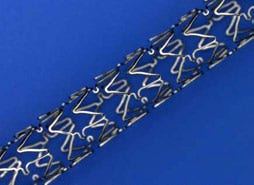Stents Could Be As Good As Coronary Bypass Surgery
November 1, 2016
The findings come from an international study involving 1905 patients with left main coronary artery disease.
Nancy Crotti
 A new international study has found that drug-eluting stents are as effective as surgery for many patients with a blockage in the left main coronary artery.
A new international study has found that drug-eluting stents are as effective as surgery for many patients with a blockage in the left main coronary artery.
In the study, 1905 patients with left main coronary artery disease (LMCAD) and low or intermediate coronary artery disease complexity were randomized to receive bypass surgery or Abbott's Xience drug-eluting stent, which releases the drug everolimus to limit the growth of scar tissue.
The patients were followed for at least two years, with a median follow-up of three years. The trial research team included interventional cardiologists and cardiac surgeons from 126 centers in 17 countries.
The researchers analyzed what happened to the patients in the first 30 days after treatment, when serious complications are most likely to occur. Within that period, stent patients had a significantly lower incidence (4.9%) of death, stroke, heart attack, or revascularization than those who had bypass surgery (7.9%). In addition, fewer stent patients had major bleeding, infections, kidney failure, or severe abnormal heart rhythms compared to those treated with surgery. Abbott funded the EXCEL (Evaluation of XIENCE versus Coronary Artery Bypass Surgery for Effectiveness of Left Main Revascularization) trial, whose results were published in the New England Journal of Medicine.
"Our study establishes stents as an acceptable or preferred alternative for patients with LMCAD and low or moderate disease complexity in the other 3 coronary arteries--about two-thirds of all LMCAD patients," said first author Gregg W. Stone, MD, director of cardiovascular research and education at the Center for Interventional Vascular Therapy at NewYork-Presbyterian/Columbia. "While bypass is still considered a more durable repair, patients and doctors may prefer a percutaneous treatment approach, which is associated with better upfront results, fewer complications, and quicker recovery."
Stents, which are placed into the diseased artery via a catheter that is inserted through a small opening in a blood vessel in the groin, arm, or neck, are a less-invasive treatment option for many people with coronary artery disease. However, coronary artery bypass surgery has long been considered the definitive treatment for patients with LMCAD, which affects a large portion of the heart muscle.
"We found that approximately 15% of patients in both groups had a heart attack, stroke, or died within three years," Stone said in a statement from Columbia. "In other words, stents were equally effective as bypass surgery."
The researchers added that bypass surgery should still be considered standard therapy for those with LMCAD and extensive blockages in the remainder of the heart arteries, although the study did not include patients with severe disease. The level of disease complexity was determined using the Syntax score, an angiographic tool for measuring disease severity.
About a year ago,Abbott touted another NEJM article that found that its Absorb everolimus-eluting bioresorbable vascular scaffold was "noninferior" to an everolimus-eluting cobalt-chromium stent at one year. FDA approved Abbott's fully resorbable cardiac stent in July, less than a year after Boston Scientific won the agency's approval for a similar device.
The results of previous randomized clinical trials suggested that first-generation drug-eluting stents might be appropriate for patients with LMCAD without extensive blockages in the remainder of the heart arteries. Those trial results were inconclusive, according to Stone.
"Since that time, stents have gotten better, and so has cardiac bypass surgery," he said. "That required us to take a fresh look at the relative safety and effectiveness of the two approaches."
Bypass surgery has long been considered the definitive treatment for patients with left main coronary artery disease, in which the artery that supplies oxygen-rich blood to most of the heart muscle is clogged with atherosclerotic plaque. About two-thirds of all LMCAD patients have mild to moderate disease in the remainder of the coronary arteries.
Nancy Crotti is a contributor to Qmed.
Like what you're reading? Subscribe to our daily e-newsletter.
[Image of Abbott Xience stent courtesy of FDA]
About the Author(s)
You May Also Like


